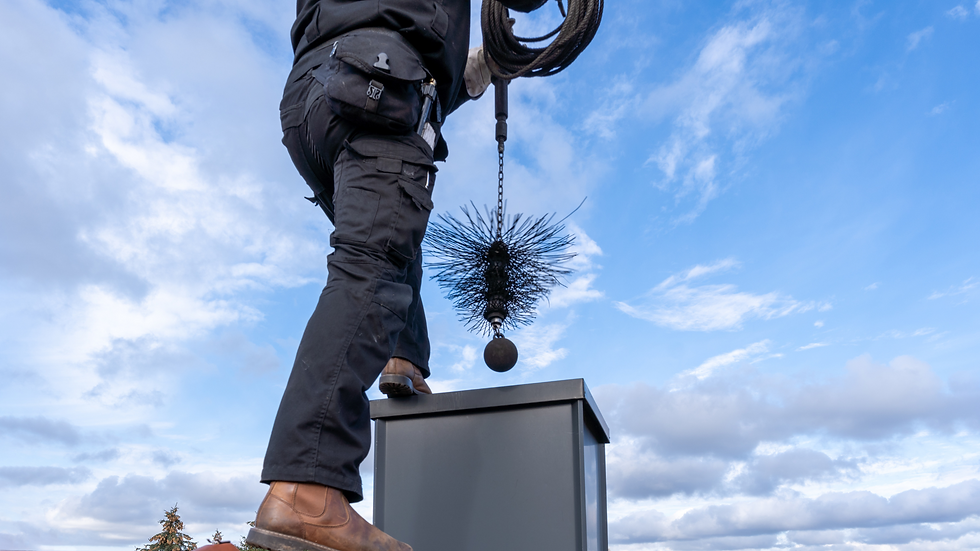How Wood Burners Work
- Gemma Alexander

- Nov 9, 2023
- 4 min read

Wood burners, also known as wood stoves, operate on a simple yet effective principle. Here's a basic rundown:
Fuel: Obviously, you start with wood. Hardwoods like oak or maple are often preferred because they burn more slowly and produce more heat.
Combustion Chamber: The wood burner has a combustion chamber where the wood is placed. This is usually a fireproof compartment where the burning takes place.
Air Supply: There are vents or dampers that control the airflow into the combustion chamber. The right balance of air is crucial for efficient burning. Too much air, and the fire burns too quickly; too little, and the wood may not burn completely.
Ignition: You start the fire using kindling or small pieces of wood. Once the fire is established, larger logs can be added.
Heat Exchange: Many modern wood burners have a system for heat exchange. They often have a series of tubes or channels that allow the hot gases produced by burning wood to circulate around the stove, transferring heat to the metal. This heat is then radiated into the room.
Chimney: Smoke and combustion byproducts are carried away through a chimney. The chimney also helps create a draft, drawing in air for combustion.
Ash Pan and Cleanout Door: Ashes accumulate as the wood burns. Some wood burners have an ash pan that can be easily removed for cleaning, and a cleanout door for periodic maintenance.
For further help and advice on choosing a wood burning stove read our other articles at News & Advice blog or browse our website www.intelligentchimneysolutions.co.uk
Are Wood Burners Expensive To Run?
The cost of running a wood burner can depend on various factors, including the efficiency of the stove, the type of wood used, and the local cost of wood. Here are some considerations:
Efficiency of the Stove: Modern, high-efficiency wood burners are designed to extract more heat from the wood, resulting in better fuel efficiency. While the initial cost of these stoves may be higher, they can save money in the long run by requiring less wood for the same amount of heat.
Type of Wood: The type of wood you use significantly influences the cost. Hardwoods like oak and maple tend to burn more slowly and produce more heat compared to softwoods. Seasoned wood with low moisture content is also preferable, as it burns more efficiently.
Local Wood Prices: The cost of purchasing wood varies by region. In some areas, wood may be a cost-effective fuel source, especially if you can source it locally. In other areas, the cost of wood might be higher, impacting the overall expense of running a wood burner.
Maintenance Costs: Regular maintenance, such as chimney cleaning and stove inspections, is essential for safety and efficiency. While this involves some cost, it's crucial for the long-term performance of the wood burner.
Initial Investment: The upfront cost of purchasing and installing a wood burner should also be considered. While this isn't a recurring cost, it's a significant factor in the overall affordability.
In summary, while there are initial costs and ongoing maintenance, the day-to-day running costs of a wood burner can be reasonable, especially if you have access to affordable wood sources and use an efficient stove. It's a good idea to calculate the specific costs based on your local conditions to determine if a wood burner is an economical choice for you.
Whats the most efficient way to use a wood burner?
To maximize the efficiency of your wood burner and get the most heat from the wood you burn, here are some tips:
Use Seasoned Wood: Burn wood that has been properly seasoned and has a low moisture content. Seasoned wood burns more efficiently and produces more heat. Freshly cut or wet wood requires energy to evaporate the water content, reducing overall efficiency.
Burn Hardwoods: Hardwoods like oak, maple, and hickory are denser and generally burn more slowly and with more heat than softwoods like pine or spruce.
Proper Loading: Don't overload the stove. Place logs in a way that allows for good airflow. Follow the manufacturer's recommendations for loading.
Start with Kindling: Use kindling or small pieces of wood to start the fire. Once the fire is established, add larger logs.
Adjust Airflow: Learn to control the airflow in your wood burner. Too much air can cause the wood to burn too quickly, while too little air can result in incomplete combustion. Adjust dampers or vents to find the right balance.
Regular Cleaning: Keep the stove and chimney clean. A buildup of creosote in the chimney can reduce efficiency and pose a fire hazard.
Use a Stove Fan: Stove fans help distribute the heat more evenly throughout the room by improving air circulation.
Close the Damper When Not in Use: When the wood burner is not in use, make sure to close the damper to prevent warm air from escaping up the chimney.
Insulate Your Home: Ensure your home is well-insulated to retain the heat generated by the wood burner.
Install a Heat Reclaimer: Some wood burners can be equipped with heat reclaimers that capture and redistribute heat that would otherwise be lost up the chimney.
Zone Heating: Focus on heating the rooms you use the most rather than trying to heat the entire house. This can be more energy-efficient.
Remember, safety is paramount. Follow the manufacturer's guidelines for your specific wood burner, and if you're unsure about anything, consult a Intelligent Chimney Solutions





Comments